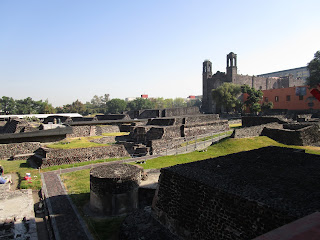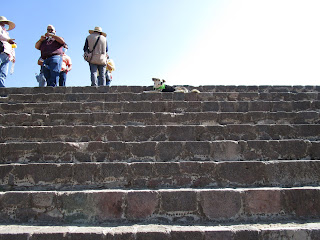 |
| Looking down on the Avenue of the Dead, with the Pyramid of the Sun to the left |
Today was the day for the other primary purpose of this trip to CDMX: Teotihuacan. (Aside: Can one have two primary purposes? Is that like arguing which of the two is "more unique"? Well, if a man can have two primary purposes for one vacation trip, Teotihuacan is the other.)
What is Teotihuacan? Teotihuacan, the tourist site, are archaeological remnants of the most important pre-Aztec city in all of Mexico and Meso-America. Teotihuacan, the pre-Aztec epicenter of Meso-American culture, was a city and religious center for 125,000 inhabitants at its peak, lasting through the first five centuries A.D. But, speaking of culture, the tourism day started with a trip to Plaza de Las Tres Culturas.
The Square of Three Cultures is an active archaeological site on the north side of Mexico City. The three cultures are the pre-hispanic (which we, on the English-speaking side of the border call "pre-Columbian), Spanish conquistador, and the modern city. All are visible in this picture. The ancient stone ruins represent the pre-hispanic. The cathedral, built from the stones of the destroyed ruins, represents Spanish culture. And, on the outskirts, is the modern culture.
In non-COVID times, you can walk among the stone ruins. Not so now. Out of fear of viral spread, the walking paths among the ruins are closed off. You may only look from a distance.
Teotihuacan is not far from the center of CDMX. But in the thick-as-a-brick Mexico City traffic it might as well be on the other side of the sun. And speaking of the sun ...
We eventually arrived at the Pyramid of the Sun, the largest structure in Teotihuacan.
Before we pulled into the Teotihuacan parking lot -- it's a new addition by the way -- the ancient cultures from 200 B.C. to 500 A.D. did not need parking lots -- we made the obligatory stop at a souvenir stand. This one, in a Mexican twist on the hard-sell souvenir store, before hard-selling you to buy the local souvenir product (here it was obsidian jewelry and decor), they ply with a tequila and pulque tasting (pulque is a pretty tasty adult beverage made from the fermented juice of the Century Plant). I bought some souvenir booze, but no obsidian.
We walked passed the enormous Pyramid of the Sun, heading for the smaller Pyramid of the Moon. And, as the hep cats used to say in the 90s,,whomp, there it is:
There were a lot of smaller buildings surrounding the two main pyramids. What were the purposes of these buildings? The pyramids were for religious ceremonies and sacrifices. (There were no human sacrifices in Teotihuacan. What? You think these people were Aztecs or something?)
But there are many theories as the purposes of these smaller buildings, but no one really seems to know for certain. They were not housing for the general population, we know that much.
It is still an active archaeological and much of the "restoration" is really best-guess re-creation.
And here is one of the many stray dogs of Teotihuacan, lounging at the base of the Pyramid of the Moon.
This is looking toward the Pyramid of the Sun:
But, first, a picture of me at the base of the Pyramid of the Moon:
One more look at the Pyramid of the Moon, from a distance this time:
And a carved serpent head:
Serpents have always played an important role in Meso-American religions. They are the symbol of the god Quetzalcoatl.
And, once again, I pose with the Pyramid of the Moon:
This is a surviving mural. The Mural of the Puma. Once upon a time murals decorated the interiors of these structures, but, for the most part, they are lost to time. The red is cinnabar.
This is along the misnamed "Avenue of the Dead." It was misnamed by the Aztecs who assumed all these structures were necropolises. They weren't. The Aztecs were wrong. It was just a long and wide boulevard. Sort of the Champs Elysees of Meso-America.
And another stray dog of Teotihuacan lounging in the sun:
This is the view of the main entrance to the Pyramid of the Sun:
The Pyramid of the Sun is largest pyramid in the New World. It is not the largest pyramid in the world. That would be the Great Pyramid of Giza in Egypt. It wins only because it is taller. The dimensions of the base are exactly the same, 230m.
Next stop in Teotihuacan was the area of the "visitor's entrance" into Teotihuacan, the Citadel, or La Citadela (that was easy). They didn't call "the visitor's entrance" back in the day, but, functionally, that is what it was. The way into the fortified site.
Greeting me was a reproduction of a carving that I saw in the National Museum of Anthropology the day before. The whole is where the heart should be, if the heart were there. And the heart ... what is it made of? The most precious material at that time in all of Meso-America. Jade.
The purpose of going to the Citadel area is to visit the Temple of Quetzalcoatl.
And what is Quetzalcoatl known for? Snakes! Lots and lots of extremely well-preserved serpent heads protruding from the building like gargoyles of a Gothic cathedral.
Alas, because of COVID restrictions you can't get any closer to the carved snake heads than this.
And that concludes Teotihuacan. My verdict on Teotihuacan? It was awesome. It was spectacular. It was well-worth the trip. BUT. There is always a "but." I thought Tikal in Guatemala was even more spectacular, even more awesome, and even more of an absolute must-see. But, then again, Tikal is probably the most awesome, most spectacular surviving site of pre-hispanic culture in all of the Americas. And, yes, Machu Picchu, that includes you! (I think. I still do want to go to Machu Picchu at some point.)
I had a buffet lunch at a nearby restaurant. As did this little birdie:
The tour was supposed to include a visit to the Basilica of Our Lady of Guadalupe. But that had to be cancelled. This Sunday is the feast day of Our Lady of Guadalupe and all roads heading to the Basilica (and there are not many) were gridlock. Basically, Teotihuacan -- 40km away -- was probably the closest parking.
So I got back to the city. Rested a spell. Then explored the neighborhood, looking for a place to eat (and there are plenty in this neighborhood). This is the night time view of Paseo de la Reforma, the street on which my hotel is found:
And I learned something very important, walking this neighborhood after dark:
El Angel de la Independencia, the Angel of Independence, located a few blocks down the street from my hotel, is even more spectacular lit up at night.




























No comments:
Post a Comment